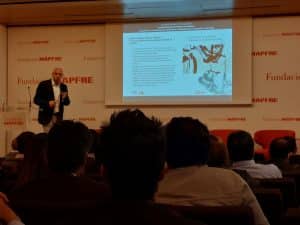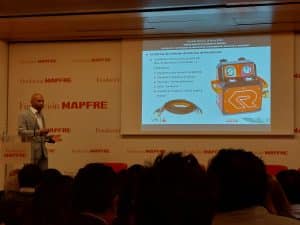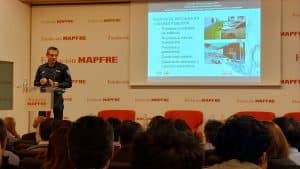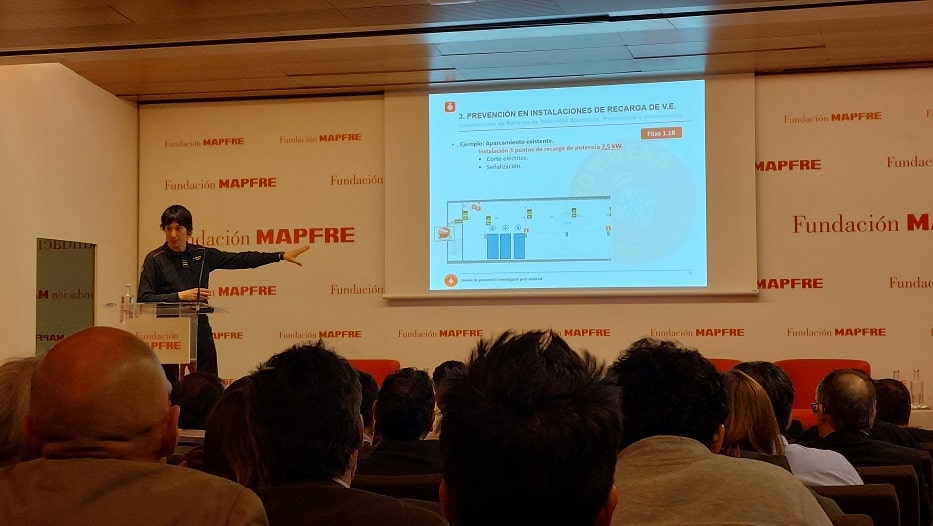Julia Maria Gomez de Avila Segade | 25/05/2023
Fundación MAPFRE hosted the APICI technical workshop on May 18. It was Jesús Monclús, the foundation’s Director of Road Safety and Prevention, who welcomed the event and proposed that, although the central theme was the risks of lithium-ion batteries; these are, in fact, safe.
The introduction for the workshop came from Andrés Pedreira, Secretary General of APICI, kicking off the first session entitled “Understanding the problem, protection and intervention.” In this case, the moderator, Eduardo García Mozos, vice president of APICI and director of engineering at MAPFRE Global Risks, turned it over to the speakers:
Sandra Pérez, CESVIMAP CASE supervisor:
 From the experience of CESVIMAP, the MAPFRE Road Safety and Experimentation Center, discussed the mobility of electric vehicles in depth. Their more than 110 professionals evaluate any technology that comes to market, specifically in the automotive field. Sandra Pérez represented Connected – Autonomous – Shared & Electric (CASE), so in her presentation she focused on the last letter; and it is that CESVIMAP has been analyzing hybrid vehicles for more than 15 years and 10 electric vehicles. The expert assured that the electric vehicle “is here to stay. On the one hand, due to society’s ecological awareness and, on the other, because of restrictive anti-contamination rules.”
From the experience of CESVIMAP, the MAPFRE Road Safety and Experimentation Center, discussed the mobility of electric vehicles in depth. Their more than 110 professionals evaluate any technology that comes to market, specifically in the automotive field. Sandra Pérez represented Connected – Autonomous – Shared & Electric (CASE), so in her presentation she focused on the last letter; and it is that CESVIMAP has been analyzing hybrid vehicles for more than 15 years and 10 electric vehicles. The expert assured that the electric vehicle “is here to stay. On the one hand, due to society’s ecological awareness and, on the other, because of restrictive anti-contamination rules.”
How is the electric vehicle market doing? According to the data used, “in 2018 the number of registrations was 6,500 (0.5% of the total) and, however, in 2022, it was 35,500 (3.75%). Although it is not a large percentage, it is clear that the trend is growing.”
An electric vehicle differs from a combustion vehicle, in addition to the power source, by engine type. Electric vehicles have fewer components, resulting in less maintenance and fewer breakdowns. These vehicles use high voltage (60 volts direct current or 30 volts alternating current) and their components are:
- Electric automobile.
- Inverter: Transforms the alternating current of the automobile into direct current to charge the battery or vice versa when the motor operates as a generator.
- Framed charger: Analyzes the type of current during the charging process.
- High voltage wiring.
- High voltage battery: It is always located between all four wheels; it is lithium-ion and the capacity is usually between 40 and 60 kW/h on average, depending on the model. The cost of the battery usually amounts to 50-55% of the vehicle’s value.
Luis Sánchez, from JonhsonControl Tyco
 JonhsonControl Tyco’s Business Development Manager initiated his exposure with the definition of Thermal Runaway. This concept refers to a battery’s flaming phase. When the battery anode and cathode (negative pole and positive pole, respectively) make contact as a result of a weakening of the element separating them, either by continuous exposure to charging and discharging processes or due to malfunction or shock, the Thermal Runway occurs. “There is a very large energy release at this time. The more energy you store, the more energy is released in the event of a fire,” says Luis Sánchez. The heat that accumulates in the damaged cell (300 or 400 °C) is transferred to the rest of the cells, thus causing a high heat release and rapidly causing the fire, reaching temperatures between 600 to one thousand degrees Celsius.
JonhsonControl Tyco’s Business Development Manager initiated his exposure with the definition of Thermal Runaway. This concept refers to a battery’s flaming phase. When the battery anode and cathode (negative pole and positive pole, respectively) make contact as a result of a weakening of the element separating them, either by continuous exposure to charging and discharging processes or due to malfunction or shock, the Thermal Runway occurs. “There is a very large energy release at this time. The more energy you store, the more energy is released in the event of a fire,” says Luis Sánchez. The heat that accumulates in the damaged cell (300 or 400 °C) is transferred to the rest of the cells, thus causing a high heat release and rapidly causing the fire, reaching temperatures between 600 to one thousand degrees Celsius.
Can this thermal runaway be detected? Today, there are major difficulties, however, it would be key to do so effectively: “Since there is no smoke in the battery heating, you have to try to detect when the gases are going to be expelled, which is when the anode and cathode are in contact with one another. This would allow us to buy time.”
Regarding the fire suppression system, the expert explains that there are no regulations or in-depth information detailing the use of common fire suppression technologies. He mentions the Euralarm, the European body of the fire and safety industry, which concludes that “it has not been proven that there is any technology that stops thermal overflow”: by placing the battery into water, the water boils; moreover, this type of fire does not need oxygen to grow, making it difficult to extinguish with the systems known today. In fact, with respect to water, it is concluded that it is optimal for cooling the area, but it would take 495 liters per minute to prevent the fire from spreading to the rest of the room. “This in an autonomy of 60 minutes, we would be talking about 30 cubic meters of water,” which, afterward, would have to undergo a drainage process for the contaminants it contains. “But there’s light at the end of the tunnel. Private researchers recommend NOVEC 1230 (a halocarbon gas) at concentrations of 15 ́2, i.e., the concentration multiplied by 3.” Its effectiveness allows to thermal overflow to be slowed by extinguishing electrolyte, multiple discharges and therefore extinguishing the fire.
Andrés Delgado from Rosenbauer
 Next, Rosenbauer’s Andrés Delgado intervened, a manufacturer of firefighting vehicles, to talk in depth about the firefighting that they perform at his company. Regardless of the source of the fire (battery overheating or external reasons), so as not to approach the source, or more precisely whenever it is located in inaccessible areas, they have designed an article that penetrates the battery by means of a piercing that expels water to cool the part and contain the temperature and finish up extinguishing the fire. While water shut-off in conventional mode consumes more than 30,000 liters, their method ensures that they consume between 600 and 1,000 liters. Working time is shorter and no human life is exposed to shut it down, thus minimizing the risk of personal injury in the event of an explosion. The aforementioned piercing penetrates up to 6.5 cm into the battery in 10 milliseconds and with water, provided by the vehicle socket or the firefighter itself, cools the battery. They have found that if they can access the battery when the fire is starting, it can take them 10-20 minutes to smother it; if it is already advanced, this can reach an hour, using 20% water.
Next, Rosenbauer’s Andrés Delgado intervened, a manufacturer of firefighting vehicles, to talk in depth about the firefighting that they perform at his company. Regardless of the source of the fire (battery overheating or external reasons), so as not to approach the source, or more precisely whenever it is located in inaccessible areas, they have designed an article that penetrates the battery by means of a piercing that expels water to cool the part and contain the temperature and finish up extinguishing the fire. While water shut-off in conventional mode consumes more than 30,000 liters, their method ensures that they consume between 600 and 1,000 liters. Working time is shorter and no human life is exposed to shut it down, thus minimizing the risk of personal injury in the event of an explosion. The aforementioned piercing penetrates up to 6.5 cm into the battery in 10 milliseconds and with water, provided by the vehicle socket or the firefighter itself, cools the battery. They have found that if they can access the battery when the fire is starting, it can take them 10-20 minutes to smother it; if it is already advanced, this can reach an hour, using 20% water.
Manuel Ferrer, Fire Corps Officer, City Hall of Madrid
 His explanation began with a statement of intent: “The solution is going to come from you (he said by addressing designers, manufacturers, users, insurance companies…), not from us. We’re going to face this with whatever we have.” The firefighter assures that lithium-ion battery fires are growing in size. “The increase is exponential.” He emphasized the speed and virulence of fire development and highlighted the situation to which the household residents or surroundings are exposed: “Your evacuation time will be shorter.” To minimize these facts, it affects the importance of awareness and teaching: where to make the loads, how to make them, not to manipulate the engines… It also moved the concern about the lack of regulations in the Community of Madrid. Environmental responsibility is now well received and many gas stations install charging stations in their mediations. “How far is it? Where is it located? It is usually in an evacuation zone and we already know that loading time is the highest risk time.” Similarly, malpractice, loading the scooter or skateboard in a hard-to-reach space, or even in public places such as shopping malls, increases human risks. For its part, the fire department of Madrid recognizes that it is learning from each of the fires it serves and highlights that it is also necessary to look at the points of battery recycling since it is a risk focus.
His explanation began with a statement of intent: “The solution is going to come from you (he said by addressing designers, manufacturers, users, insurance companies…), not from us. We’re going to face this with whatever we have.” The firefighter assures that lithium-ion battery fires are growing in size. “The increase is exponential.” He emphasized the speed and virulence of fire development and highlighted the situation to which the household residents or surroundings are exposed: “Your evacuation time will be shorter.” To minimize these facts, it affects the importance of awareness and teaching: where to make the loads, how to make them, not to manipulate the engines… It also moved the concern about the lack of regulations in the Community of Madrid. Environmental responsibility is now well received and many gas stations install charging stations in their mediations. “How far is it? Where is it located? It is usually in an evacuation zone and we already know that loading time is the highest risk time.” Similarly, malpractice, loading the scooter or skateboard in a hard-to-reach space, or even in public places such as shopping malls, increases human risks. For its part, the fire department of Madrid recognizes that it is learning from each of the fires it serves and highlights that it is also necessary to look at the points of battery recycling since it is a risk focus.
Víctor Molinet, Head of the Barcelona Fire Regulations and Benefits Unit
 From the operational and prevention part, they have worked what they call the “new challenge” of electrical mobility. “Time will tell us if the risk assumed has been greater or less than what we have learned to work with for many years.” Accidents where electric vehicles (scooters, bicycles…) are involved have increased considerably: “In 2018, there were two fires and in 2022, 54.” In this regard, what regulations are there? Molinet states that the regulations in Catalonia regulates the electrical part, but does not regulate the building, that is, if it has to contain any resource to prevent or minimize fire damage. In countries such as Switzerland, France and the United States, among others, they define what to do to install charging points in buildings and ships, for example, since in the transport of electric vehicles, fires have occurred during travel. The regulations they have developed include three points of view:
From the operational and prevention part, they have worked what they call the “new challenge” of electrical mobility. “Time will tell us if the risk assumed has been greater or less than what we have learned to work with for many years.” Accidents where electric vehicles (scooters, bicycles…) are involved have increased considerably: “In 2018, there were two fires and in 2022, 54.” In this regard, what regulations are there? Molinet states that the regulations in Catalonia regulates the electrical part, but does not regulate the building, that is, if it has to contain any resource to prevent or minimize fire damage. In countries such as Switzerland, France and the United States, among others, they define what to do to install charging points in buildings and ships, for example, since in the transport of electric vehicles, fires have occurred during travel. The regulations they have developed include three points of view:
-
-
- Where these charging points can be located.
- Legalization procedures. What procedures are required for said installation.
- What measures the buildings must comply with where the charging points are installed.
-
In 2021, a technical guide was published indicating the regulations and procedures required for the installation of a charging point. He highlighted four points:
-
-
- It is important to signal it to help identify the electrical charge.
- General power outage at the charging site on fire. Although it requires technical conditioning, it is not complex, and it is observed that all European regulations include them.
- The location. Since the lower the grade, the more difficult access will be, powers greater than 8 kW are not accepted below basement -1.
- Sectorization. When placing major electrical charging, sectorization is required, so that fires do not spread from vehicle to vehicle, thus not collapsing the structure.
- All parking lots must have sprinklers when charges are greater than 8kW. And of course, provide adequate water collection.
-
Keep reading… Baterías de ión-litio: jornadas técnicas de APICI





